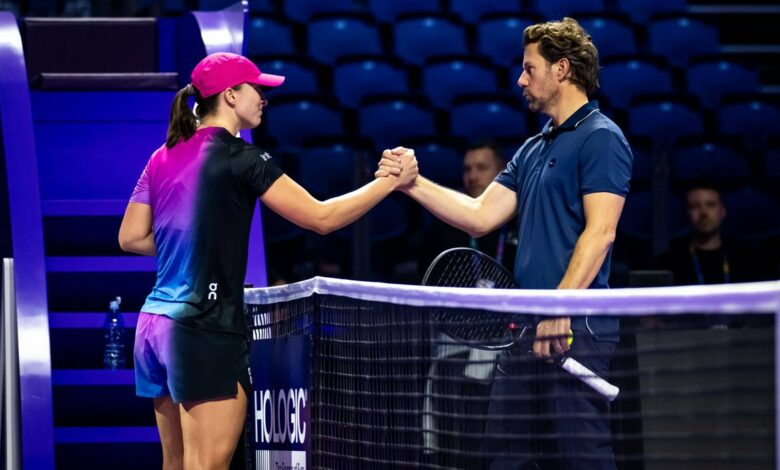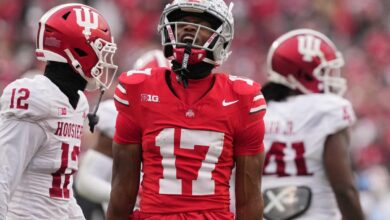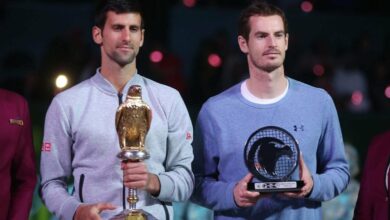Wim Fissette and Iga Swiatek’s partnership: What to expect and how he coaches players

What happens when you pair the best player on the WTA Tour with one of its most decorated coaches?
That was the question in October, when then world No. 1 Iga Swiatek brought on Wim Fissette as her head coach. Fissette, a cerebral 44-year-old from Belgium, is widely considered one of the top coaches on the women’s tour after achieving so much success with such a range of players.
Fissette, who never cracked the top 1,000 as a player in the 1990s and early 2000s, has excelled as a coach ever since his first job with compatriot Kim Clijsters. At 29, he coached Clijsters when she won the 2009 U.S. Open having only just returned from maternity leave, and was in her corner for three major titles in total.
He has since coached an all-star list of players, taking in Sabine Lisicki, Simona Halep, Victoria Azarenka (twice), Petra Kvitova, Sara Errani, Johanna Konta, Angelique Kerber, Zheng Qinwen and most recently Naomi Osaka. Fissette and Osaka split in September when she replaced him with the other most celebrated coach on the WTA Tour, Patrick Mouratoglou.
Under Fissette’s guidance, Osaka won the 2020 U.S. Open and 2021 Australian Open, taking his Grand Slam total as a coach to six after Kerber’s Wimbledon win of 2018. He also took both Lisicki (2013 Wimbledon) and Halep (2014 French Open) to their first Grand Slam finals. In 2017, he helped Konta win the WTA 1000 Miami Open and reach the Wimbledon semifinals for the first time, achieving a career-high ranking of No. 4.
His first tournament with Swiatek sees him tasked with defending a title and helping to orchestrate a possible return to the top of the world rankings after she relinquished the No. 1 slot to Aryna Sabalenka having dropped points for missing mandatory tournaments. She opens her WTA Tour Finals campaign in Riyadh, Saudi Arabia against Wimbledon champion Barbora Krejcikova, in a round-robin group also containing Coco Gauff and Jessica Pegula, the latter of whom Swiatek thrashed to win last year’s event in Cancun, Mexico.
Despite his reputation and glittering CV, Fissette has remained largely anonymous, in one of few sports where it is possible for an elite coach to keep a low media profile. It’s players who conduct post-match interviews and press conferences, unlike football in which, while players will speak, it’s the manager’s opinion and feelings that are sought after every win, draw, or defeat.

Wim Fissette and Iga Swiatek’s first event together is the WTA Tour Finals. (Robert Prange / Getty Images)
Speaking to those who have worked with Fissette and seen him operate up close, as well as sources close to Swiatek, some of whom have spoken anonymously to protect relationships, The Athletic has taken a deeper look at how the Belgian operates to understand one of the most exciting coaching partnerships in recent memory as it moves from the practice courts to a stadium for the first time.

GO DEEPER
After two years of chaos, Garbine Muguruza seeks WTA Tour Finals normality in Riyadh
There is an alchemy in the coach-player relationship that makes it not always so easy to predict, even with someone as experienced and adaptable as Fissette. Players frequently talk about their partnership with a coach in romantic terms, making the point that sometimes you click with someone, sometimes you don’t.
And every player needs a different kind of coach. At the Laver Cup in September, the American world No. 15 Frances Tiafoe explained his partnership with new coach David Witt, who formerly worked with U.S. Open finalist Jessica Pegula and before that Maria Sakkari.
“I’m definitely a unique personality, especially in this sport, and someone needs to push me and hold me accountable but also make it fun for me,” Tiafoe said in a news conference.
“I’m a guy where, if you come at me with a drill-sergeant-type mentality, I’m going to go the other way.”
“So much is about the chemistry,” Daniela Hantuchova, the former world No 5 said in a recent phone interview.
“I always felt that you could never tell how it would feel with a coach until you’d worked with them for a few months and you understood their personality, and how they work.
“He (Fissette) is a very impressive coach but just because it works for someone else doesn’t mean it will work for you. It’s very personal.”
When Swiatek split with coach Tomasz Wiktorowski in early October, well-placed sources within women’s tennis tipped Fissette to replace him, given his availability and Swiatek’s apparent willingness to rip up the formula that won her four out of her five Grand Slams. Since winning a third consecutive French Open in June, Swiatek’s performances and results have been patchy, and she’s spoken a few times of mental and physical exhaustion.
After discussions and analysis with her team, Swiatek approached Fissette for talks which drew her to his keenness to learn and develop.
“Iga was keen on working with someone who is open-minded, a good leader but a team player at the same time,” a member of her team told The Athletic.
“They both are very eager to constantly work on themselves, so they have a similar mindset. That’s why Iga believes they can get along well. His great experience with Grand Slam champions and other players who were ranked No 1 in the world was an additional advantage.”
‘Emotional intelligence’ is a phrase that sticks to Fissette, who combines it with an appreciation for data and statistics that goes all the way back to his first job as a coach: helping Clijsters win the 2009 U.S. Open in only her third tournament back after giving birth to her daughter, Jada.

Wim Fissette (left) with Kim Clijsters after she won the Miami Open title in 2010. (Clive Brunskill / Getty Images)
John Dolan was Clijsters’ manager at the time.
“Wim is an amazing coach. Very emotionally intelligent, and he can adapt his personality to the player he’s working with,” Dolan, a long-time WTA media liaison who is now the head of media for the British Lawn Tennis Association, said in an interview last month.
“He was a very good listener, and doesn’t talk a lot like some people. When he does say something it carries real importance and over the last 15 years his coaching credentials speak for themselves.
“If you’re a player how can you not listen to him?”
Knowing when to push and when to pull back is a key skill of any coach. Fissette is no hype man, so when he does really try to motivate his players, the effect is greater. With Clijsters, at her first tournament back in Cincinnati, she came to her coach with doubts about whether she was really good enough to compete. In an interview with Essentially Sports in 2018, Fissette said he told Clijsters that “there’s really nobody that is able to beat you when you’re going to be at your best.”
Ahead of her U.S. Open semifinal against Serena Williams, a player Clijsters had only beaten once in eight meetings prior, Fissette focused on not worrying and exploiting Williams’ weaknesses. Clijsters won 6-4, 7-5 in a match overshadowed by Williams being given a point penalty when down match point. Fissette had earlier that season bet Clijsters that if she won the tournament, he would shave his head. Both did their part in the deal.
“It sounds obvious but he knows how to work with tennis players,” Dolan said. “Some other coaches haven’t quite learned that reading the player is such a big part of it and a lot of coaches don’t have that. They focus too much on themselves.”
When Naomi Osaka began discussing who would coach her on her return to the tour after giving birth, reuniting with Fissette was the obvious choice. He did not say yes straight away.
He pushed Osaka on how her comeback would work and why it would be different to previous comebacks in 2021 and 2022 which ended prematurely. In the end, the second edition of Osaka-Fissette lasted just under a year.
An official at the WTA, who requested anonymity to protect relationships, outlined Fissette’s directness.
“He’s absolutely not a cheerleader,” they said.
“He’s very honest, and that is something some players aren’t used to all the time. He’ll say, ‘I have some ideas. If you’re open to that this is going to work — if you’re not going to be open to criticism, then it’s not.’”
“When you put in the effort, I make sure to praise it, while still being critical of errors,” Fissette writes on his website.
“I’m always looking for ways to make you better than the day before. Be positive, be better.”
Fissette undoubtedly has a ruthless streak. He joined up with Osaka in September 2023 having just taken Zheng to her first Grand Slam quarterfinal at the U.S. Open. Zheng said she was blindsided and heartbroken; Fissette told The Athletic in January that he was going to stop coaching Zheng regardless of Osaka. He had nothing but praise for Zheng — “a super nice girl” who always worked hard — but said that they did not click.

Wim Fissette (crouching) with Naomi Osaka in Los Angeles earlier this year. (Matt Futterman / The Athletic).
Similarly, in 2018, Fissette split with Kerber towards the end of what had been a very successful year and reunited with Azarenka shortly after. A terse statement from Kerber at the time read: “Wim Fissette is — with immediate effect — exempted from his duties as coach of Angelique Kerber. In spite of the successful cooperation since the beginning of the season, this step is necessary due to differences of opinion regarding the future of the alignment.”
A year earlier, Fissette and Konta split, with the former saying in an interview with the Times of London: “It was a good match but not a perfect match. We are kind of different and we see things a little different.”
The split was amicable with the now de rigueur posts on social media praising each other; Konta was unavailable for interview for this piece when asked by The Athletic.
Fissette’s willingness to curtail a partnership that doesn’t work — which players will share — stands in apparent contrast to the depth to which he will tailor his approach to a player’s needs. He is “very tour-friendly,” the WTA official said.
“He sees coaching as an art form. He understands how it works and really cares about what he does,” they added.
Fissette would get so nervous during Konta’s matches that he would have to go for a run afterwards to unwind.
In an interview with ESPN.com in 2018, Fissette detailed the spectrum on which his players would understand their own matches, with Azarenka’s desire for large amounts of data contrasting to Kerber wanting “two, three important things.”
This was partly a determination of style: Kerber’s at-times scarcely believable ability to turn defense into attack was reliant on knowledge of an opponent’s preferred attacking shots and patterns, allowing her to be strategically proactive rather than merely reacting to the ball in front of her.
When he was coaching Konta, Fissette was more prescriptive than usual. She liked clear messaging and so Fissette would have her recite the gameplan and a few key thoughts to him and herself before she went on court. But Konta was more lighthearted before matches than some of the players he’d worked with, so Fissette lent into that too. “We all tell jokes. Everybody is different,” Fissette told the Press Association during Konta’s run to the Wimbledon semifinals in 2017.
This is true of Fissette himself, who modelled his game on counter-punching as a player but has since made aggression one of the key tenets of his coaching. On the way to Kerber’s win at Wimbledon in 2018, he told her to up her aggression more than usual in moments where she would feel compelled to be safe; he used a similar strategy with Osaka when she came within a point of knocking Swiatek out of this year’s French Open.
“The way you think about tennis and play tennis trickles down into how you coach and how you play tennis,” Filip Dewulf said in a phone interview earlier this month.
Dewulf, 52, is a former French Open semifinalist and world No. 39; he was playing when Fissette was trying to make it on the ATP Tour. They got to know each other then and live near each other in Belgium, sometimes meeting for a drink and a catch-up.

Wim Fissette and Angelique Kerber celebrating victory at Wimbledon in 2018. (Clive Mason / Getty Images)
“He’s very data-driven. Both about his own player but also the opponent. He is preparing himself really well every match, and every practice, looking at the numbers every day,” Dewulf said.
Fissette would use an iPad between sets when coaching Kerber, and his use of data combined with the emotional intelligence that Dewulf, like most people interviewed for this article, cites as key to his success results in a drive to improve and develop, but with a real end result. Developing but losing is not Fissette’s goal.
“We had three nice years, we won two slams, and it was really good. But I was, in some ways, disappointed,” he told The Athletic in January of his first stint with Osaka.
How these coaching philosophies will translate into Swiatek’s game, mentality, and team will unfold over time, but those who have worked with him offer perspectives on where he fits into her way of approaching tennis. Dewulf has labelled Fissette as a “good organizer” with the ability to analyze an existing partnership from a removed perspective, appreciating its strengths while looking into its weaknesses.
Konta and Azarenka worked with a mental coach and psychologist respectively while Fissette coached them; at the very start of their first partnership in 2020, Osaka was in a dark place. She had lost to Coco Gauff in the Australian Open third round as the defending champion, and then lost her good friend Kobe Bryant, who died shortly after. The COVID-19 pandemic led to tennis being stopped a couple of months later, but Osaka found the equilibrium to win that year’s U.S. Open in September 2020 and then the Australian Open the following year.
“If they have been the same way for a long time, he works out what the weakness are and he gets other people in to get a better team around them,” Dewulf said.
This will be an interesting sub-plot with Swiatek, who has a number of longstanding team members including psychologist Daria Abramowicz. Fissette has been known to experiment: he and Osaka’s team brought in ballet dancer Simone Elliott to help her improve her movement.
Swiatek has said that tactical and technical adaptations to her game will come in the off-season, with too little time between hiring Fissette and the Tour Finals to implement meaningful changes, but she has already discussed what is coming.
“I for sure want to improve my serve, as I’ve been doing for past years,” she said in a news conference in Riyadh. “I think tactically there are many ways I could go and have more variety on court. Wim has some nice ideas.”
Swiatek has added more speed to her serve and abbreviated her motion in 2024, but recent defeats have been marked by an inability to change the momentum of matches, too often trying to hit through opponents in the way that usually wins her matches, instead of changing tempo or adding margin with topspin — one of her great strengths — to earn an easier ball back. This simplification of her game, introduced by Wiktorowski, brought her great success and continues to do so; it still needs an alternative for when it isn’t quite working.
Fissette worked with Kerber and Azarenka extensively on their serves, and spent time with Osaka trying to develop an aggressive open-stance backhand — a shot that a handful of players, including Swiatek, can perform reliably.
As Swiatek heads into defending her WTA Tour Finals title, Fissette’s generally quick starts may prove a boon. Clijsters is the most obvious example but Konta won Miami, the biggest title of her career, within a few months of working with him. Lisicki was a shock Wimbledon finalist after an even shorter time working with Fissette, while Halep reached her first Grand Slam quarterfinal in her first major with Fissette, before reaching the French Open final in her second.
This instant impact is something a few observers have pointed to as a Fissette trademark.
Ultimately, it’s Fissette’s record of success that sets him apart, says his coaching rival Mouratoglou, who won 10 Grand Slams with Serena Williams between 2012 and 2017. “I judge the quality of a coach on the results,” Mouratoglou said from France via a Zoom interview this week.
“There are some guys who make results and some guys who don’t, and some who do it sometimes. It’s the same if you look at the football, there are a few coaches every time they take a team — success. Of course, they’re great teams, but with other coaches, they wouldn’t make that success.”
“I have a good relationship with him, he’s one of the guys that I’m always happy to see even though we are in competition,” Mouratoglou said.
“I think we have very different personalities but it’s good that there are different options for the players.”
One undoubted advantage is how intimately Fissette knows a number of Swatek’s rivals from working with them. Coaching Osaka at the 2020 U.S. Open final, Fissette felt as though he could predict every shot that Azarenka was going to hit. He will now be able to tell Swiatek precisely what her opponents will be anticipating from her because he was in the role of anticipator for Osaka only a few months ago.
Fissette’s expertise on the WTA Tour leads to the inevitable question about why he has never coached a male player, but the answer is that the opportunity hasn’t come up. He is open to doing so but his early success with Clijsters led to job offers on the women’s side and that’s how it’s been ever since. It’s hard to imagine he wouldn’t be a success there, given what he’s achieved in 15 years on the WTA side.
It feels difficult to envisage a situation where the partnering of two such elite practitioners won’t equate to success either in the medium term or more immediately, like some of Fissette’s previous partnerships. What makes tennis so exciting is not quite knowing how things will go — even if this feels like the closest thing to a sure bet.
(Top photo: Robert Prange / Getty Images)




